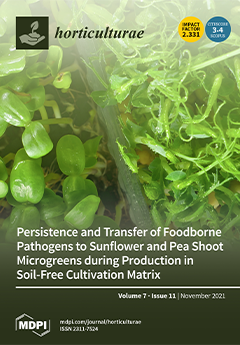Elevated carbon dioxide (EC) can increase the growth and development of different C
3 fruit crops, which may further increase the nutrient demand by the accumulated biomass. In this context, the current investigation was conceptualized to evaluate the growth performance and nutrient uptake
[...] Read more.
Elevated carbon dioxide (EC) can increase the growth and development of different C
3 fruit crops, which may further increase the nutrient demand by the accumulated biomass. In this context, the current investigation was conceptualized to evaluate the growth performance and nutrient uptake by tomato plants under elevated CO
2 (EC
700 and EC
550 ppm) and temperature (+2 °C) in comparison to ambient conditions. Significant improvement in the growth indicating parameters like leaf area, leaf area index, leaf area duration and crop growth rate were measured at EC
700 and EC
550 at different stages of crop growth. Further, broader and thicker leaves of plants under EC
700 and EC
550 have intercepted higher radiation by almost 11% more than open field plants. Conversely, elevated temperature (+2 °C) had negative influence on crop growth and intercepted almost 7% lower radiation over plants under ambient conditions. Interestingly, earliness of phenophases viz., branch initiation (3.0 days), flower initiation (4.14 days), fruit initiation (4.07 days) and fruit maturation (7.60 days) were observed at EC
700 + 2 °C, but it was statistically on par with EC
700 and EC
550 + 2 °C. Irrespective of the plant parts and growth stages, plants under EC
700 and EC
550 have showed significantly higher nutrient uptake due to higher root biomass. At EC
700, the tune of increase in total nitrogen, phosphorus and potassium uptake was almost 134%, 126% and 135%, respectively compared to open field crop. This indicates higher nutrient demand by the crop under elevated CO
2 levels because of higher dry matter accumulation and radiation interception. Thus, nutrient application is needed to be monitored at different growth stages as per the crop needs.
Full article





